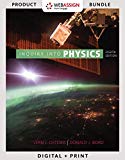
Concept explainers
The "shot" used in the shot-put event is a metal ball with a mass of 7.3 kg. When thrown in Olympic competition, it is accelerated to a speed of about 14 m/s. As an approximation, let's say that the athlete exerts a constant force on the shot while throwing it and that it moves a distance of 3 m while accelerating.
(a) What is the shot's kinetic energy?
(b) Compute the force that acts on the shot.
(c) It takes about 0.5 s to accelerate the shot. Compute the power required. Convert your answer to horsepower.
(a)
The kinetic energy of the shot.
Answer to Problem 6C
The kinetic energy of the shot is
Explanation of Solution
Given:
The “shot” used in the shot-put event is a metal ball with a mass of
Formula used:
Kinetic energy is given as
Where,
Calculation:
We have,
Mass of shot,
Speed of shot,
Thus, kinetic energy of shot is calculated as
Conclusion:
Hence, the kinetic energy of the shot is
(b)
The force that acts on the shot.
Answer to Problem 6C
The force that acts on the shot is
Explanation of Solution
Given:
The “shot” used in the shot-put event is a metal ball with a mass of
Formula used:
There the four equations of motions, listed below:
Where,
Calculation:
Given that the shot is accelerated to a speed of about
Thus, we have
Using equation of motion, we have
Substituting the values, we get
Also, we know that force is calculated as
Substituting the values, we get
Conclusion:
Hence, the force that acts on the shot is
(c)
The “shot” used in the shot-put event is a metal ball with a mass of
Answer to Problem 6C
The power required is
Explanation of Solution
Given:
Given that shot used shot-put event is a metal ball with a mass of
Formula used:
There the four equations of motions, listed below:
Where
Also, Power is given as,
Calculation:
Given that the shot is accelerated to a speed of about
Thus, we have
Using equation of motion, we have
Substituting the values, we get
Also, we know that force is calculated as
Substituting the values, we get
Conclusion:
Hence, the power required is
Want to see more full solutions like this?
Chapter 3 Solutions
Bundle: Inquiry into Physics, Loose-Leaf Version, 8th + WebAssign Printed Access Card for Ostdiek/Bord's Inquiry into Physics, 8th Edition, Single-Term
- 20. Two small conducting spheres are placed on top of insulating pads. The 3.7 × 10-10 C sphere is fixed whie the 3.0 × 107 C sphere, initially at rest, is free to move. The mass of each sphere is 0.09 kg. If the spheres are initially 0.10 m apart, how fast will the sphere be moving when they are 1.5 m apart?arrow_forwardpls help on allarrow_forwardpls help on thesearrow_forward
- pls help on all asked questions kindlyarrow_forwardpls help on all asked questions kindlyarrow_forward19. Mount Everest, Earth's highest mountain above sea level, has a peak of 8849 m above sea level. Assume that sea level defines the height of Earth's surface. (re = 6.38 × 106 m, ME = 5.98 × 1024 kg, G = 6.67 × 10 -11 Nm²/kg²) a. Calculate the strength of Earth's gravitational field at a point at the peak of Mount Everest. b. What is the ratio of the strength of Earth's gravitational field at a point 644416m below the surface of the Earth to a point at the top of Mount Everest? C. A tourist watching the sunrise on top of Mount Everest observes a satellite orbiting Earth at an altitude 3580 km above his position. Determine the speed of the satellite.arrow_forward
- pls help on allarrow_forwardpls help on allarrow_forward6. As the distance between two charges decreases, the magnitude of the electric potential energy of the two-charge system: a) Always increases b) Always decreases c) Increases if the charges have the same sign, decreases if they have the opposite signs d) Increases if the charges have the opposite sign, decreases if they have the same sign 7. To analyze the motion of an elastic collision between two charged particles we use conservation of & a) Energy, Velocity b) Momentum, Force c) Mass, Momentum d) Energy, Momentum e) Kinetic Energy, Potential Energyarrow_forward
 Principles of Physics: A Calculus-Based TextPhysicsISBN:9781133104261Author:Raymond A. Serway, John W. JewettPublisher:Cengage Learning
Principles of Physics: A Calculus-Based TextPhysicsISBN:9781133104261Author:Raymond A. Serway, John W. JewettPublisher:Cengage Learning University Physics Volume 1PhysicsISBN:9781938168277Author:William Moebs, Samuel J. Ling, Jeff SannyPublisher:OpenStax - Rice University
University Physics Volume 1PhysicsISBN:9781938168277Author:William Moebs, Samuel J. Ling, Jeff SannyPublisher:OpenStax - Rice University Glencoe Physics: Principles and Problems, Student...PhysicsISBN:9780078807213Author:Paul W. ZitzewitzPublisher:Glencoe/McGraw-Hill
Glencoe Physics: Principles and Problems, Student...PhysicsISBN:9780078807213Author:Paul W. ZitzewitzPublisher:Glencoe/McGraw-Hill Physics for Scientists and Engineers, Technology ...PhysicsISBN:9781305116399Author:Raymond A. Serway, John W. JewettPublisher:Cengage Learning
Physics for Scientists and Engineers, Technology ...PhysicsISBN:9781305116399Author:Raymond A. Serway, John W. JewettPublisher:Cengage Learning Physics for Scientists and Engineers: Foundations...PhysicsISBN:9781133939146Author:Katz, Debora M.Publisher:Cengage Learning
Physics for Scientists and Engineers: Foundations...PhysicsISBN:9781133939146Author:Katz, Debora M.Publisher:Cengage Learning College PhysicsPhysicsISBN:9781285737027Author:Raymond A. Serway, Chris VuillePublisher:Cengage Learning
College PhysicsPhysicsISBN:9781285737027Author:Raymond A. Serway, Chris VuillePublisher:Cengage Learning





